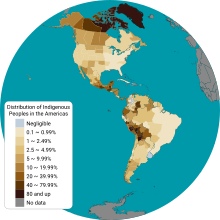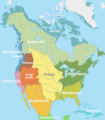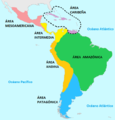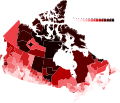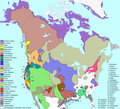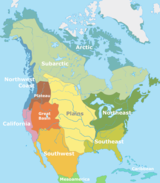Portal:Indigenous peoples of the Americas
The Indigenous peoples of the Americas PortalIn the Americas, Indigenous peoples comprise the continent's pre-Columbian inhabitants prior to European settlement in the 15th century, as well as the ethnic groups that identify with the continent's pre-Columbian population as such. These populations exhibit significant diversity; some Indigenous peoples were historically hunter-gatherers, while others practiced agriculture and aquaculture. Various Indigenous societies developed complex social structures, including pre-contact monumental architecture, organized cities, city-states, chiefdoms, states, kingdoms, republics, confederacies, and empires. These societies possessed varying levels of knowledge in fields such as engineering, architecture, mathematics, astronomy, writing, physics, medicine, agriculture, irrigation, geology, mining, metallurgy, sculpture, and goldsmithing. Indigenous peoples continue to inhabit many regions of the Americas, with significant populations in countries such as Bolivia, Canada, Chile, Colombia, Ecuador, Guatemala, Mexico, Peru, and the United States. There are at least a thousand different Indigenous languages spoken across the Americas, with 574 federally recognized tribes in the US alone. Some languages, including Quechua, Arawak, Aymara, Guaraní, Mayan, and Nahuatl, have millions of speakers and are recognized as official by governments in Bolivia, Peru, Paraguay, and Greenland. Indigenous peoples, whether residing in rural or urban areas, often maintain aspects of their cultural practices, including religion, social organization, and subsistence practices. Over time, these cultures have evolved, preserving traditional customs while adapting to modern needs. Some Indigenous groups remain relatively isolated from Western culture, with a few still considered uncontacted peoples. (Full article...) Selected article The indigenous people of the Everglades region arrived in the Florida peninsula of what is now the United States approximately 14,000 to 15,000 years ago, probably following large game. The Paleo-Indians found an arid landscape that supported plants and animals adapted to prairie and xeric scrub conditions. Large animals became extinct in Florida around 11,000 years ago. Climate changes 6,500 years ago brought a wetter landscape. The Paleo-Indians slowly adapted to the new conditions. Archaeologists call the cultures that resulted from the adaptations Archaic peoples. They were better suited for environmental changes than their ancestors, and created many tools with the resources they had. Approximately 5,000 years ago, the climate shifted again to cause the regular flooding from Lake Okeechobee that gave rise to the Everglades ecosystems. From the Archaic peoples, two major tribes emerged in the area: the Calusa and the Tequesta, who were of Taíno origin, an Arawak people, originating from the Caribbean and South America. The earliest written descriptions of these people come from Spanish explorers who sought to convert and conquer them. Although they lived in complex societies, little evidence of their existence remains today. The Calusa were more powerful in number and political structure. Their territory was centered on modern-day Ft. Myers, and extended as far north as Tampa, as far east as Lake Okeechobee, and as far south as the Keys. The Tequesta lived on the southeastern coast of the Florida peninsula around what is today Biscayne Bay and the Miami River. Both societies were well adapted to live in the various ecosystems of the Everglades regions. They often traveled through the heart of the Everglades, though they rarely lived within it. Selected image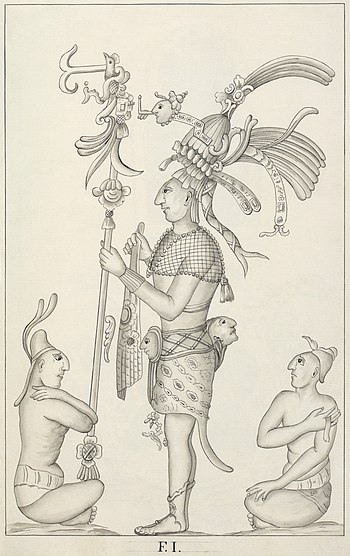 Stucco relief at the Maya ruins at Palenque, as drawn by Ricardo Almendáriz at the time of the Del Rio expedition in 1787 image credit: Library of Congress
General imagesThe following are images from various Indigenous peoples of the Americas-related articles on Wikipedia.
Selected biography Ishi (c. 1860 – March 25, 1916) was the last member of the Yahi, a group of the Yana people of the U.S. state of California. Widely acclaimed in his time as the "last wild Indian" in America, Ishi lived most of his life completely outside modern culture. At about 49 years of age, in 1911, he emerged from "the wild" near Oroville, California, leaving his ancestral homeland, present-day Tehama County, near the foothills of Lassen Peak, known to Ishi as Wa ganu p'a. Ishi means "man" in the Yana language. The anthropologist Alfred Kroeber gave this name to the man because it was rude to ask someone's name in the Yahi culture. When asked his name, he said: "I have none, because there were no people to name me," meaning that no Yahi had ever spoken his name. He was taken in by anthropologists at the University of California, who both studied him and hired him as a research assistant. He lived most of his remaining five years in a university building in San Francisco. Did you know…
SubcategoriesRelated portalsThings you can do
Selected panoramaTopicsRecognized content
Featured articlesFormer featured articlesGood articles
Former good articlesDid you know? articles
In the News articlesAssociated WikimediaThe following Wikimedia Foundation sister projects provide more on this subject:
American indigenous language WikipediasAvañe'ẽ (Warani) · Aymar aru (Aymara) · ᏣᎳᎩ (Cherokee) · Chahta (Choctaw) · ᐃᔨᔫ (Cree) · ᐃᓄᒃ (Inuktitut) · Iñupiak · Kalaallisut (Greenlandic Inuit) · Mvskoke (Muscogee) · Nahuatlahtolli · Diné bizaad (Navajo) · Qhichwa Simi · Tsêhesenêstsestôtse (Cheyenne) Indigenous languages in Wikimedia Incubators: Alabama · Blackfoot · Chinook Jargon · Choctaw · Creek · Lakota · Micmac · Mohawk · Nheengatu · Northwestern Ojibwa · O'odham · Shoshoni · Unami-Lenape · Wüne pakina (Mapudungun) · Yucatec Maya · Central Alaskan Yup'ik · Zuni |

